Did another trip to the NC Botanical Gardens yesterday, to see what could be found, and the answer to that is anoles. Lots of anoles.

I have noticed that each year, the representative numbers of certain species seem to fluctuate, or at least according to what I have been able to find, anyway. While the botanical gardens have always been a good place to find Carolina anoles (Anolis carolinensis,) this year especially they seem numerous, with plenty of young ones to be seen (if you take the time and have good eyes,) like the one above – note the shorter nose. The plants in this region, at least, haven’t changed at all, but it’s convincing me to get some ginger lilies like this planted around Walkabout Estates. Where the numbers of anoles have also increased; coincidence, or climate/habitat? Can’t say. I have noticed, for instance, surges at times in the green lynx spiders, or the magnolia green jumping spiders, and reductions in the numbers of barn spiders and spined micrathena, the former a small percentage of the previous years and the latter has about disappeared since we moved in. I’m certain there are a lot of factors involved, including temperatures and rainfall in the spring and fall, number of available predators during hatching or laying seasons, and so on. So is there a trend, or just normal variations?

While we (meaning the Infernal Mr Bugg and I) have numerous photos of the juveniles, the adults provided the best poses, more likely to hang around without fleeing for cover, instead relying on their typical stealth and camouflage. Here an adult creeps up a small sapling in deep shade, taking a moment to gaze skyward – probably asking the reptile gods to get rid of these pesky paparazzi. The sky was too clear for smiting, however, deities being restricted by the availability of thunderheads.

I perhaps raised its hopes for a brief moment, but it was only the macro flash unit firing off – you can see that look in its eye, the anticipation of seeing me collapse into a blackened cinder. At least that’s what it looks like to me.
Another adult, creeping up the greenbriar vines in full sunlight, could have been doing a better job of hiding, but yeah, I’ll take it.

In most of the cases, it was the movement of the anole that attracted my attention, though a few were found while motionless. They’re good about knowing what they blend in with well, better than the green treefrogs, and tend to stay tucked in and close to the surface so they don’t present either odd shapes or ‘protrusions’ to give themselves away. Though one wasn’t quite aware of the overall effect.

Easily my favorite shot, and I quickly maneuvered around for the best angle the moment that I spotted the shadow, expecting the anole to leap away from the leaf as soon as it realized it had been discovered. But the whole-body, detailed silhouette was too good to pass up, and being visible actually peeking around the edge of the leaf was simply a bonus. Thankfully, we both got plenty of time to ensure that focus was bang on, because the lizard was pretty complacent, though we were admittedly being as low key as possible. Even after I’d done my shots and backed off, I was able to approach from another side as Buggato was getting his own photos (hey, I’ll kindly allow others to get their shots first, unless it’s a seriously great opportunity from something that may not last, in which case I make sure I get what I want first. I spotted it, after all.)

For this one, the shadow wasn’t quite as compelling, and I cropped in tighter for the eye and scale detail – not to mention those little toes. And yes, the anole was fully vertical, mostly suspended by one toe on the opposite foot digging into the leaf, but seriously, there’s not a lot if weight to account for here (and I’m not even going to try and guess, but probably less than half the weight of an ordinary wood pencil.) Body length, without tail, was 60mm or less, with the head being in the range of 10mm wide.
It’s hard to provide scale with any kind of wild shot, but the next gives a faint indication, obtained immediately before the two above, and a lot trickier to snag.
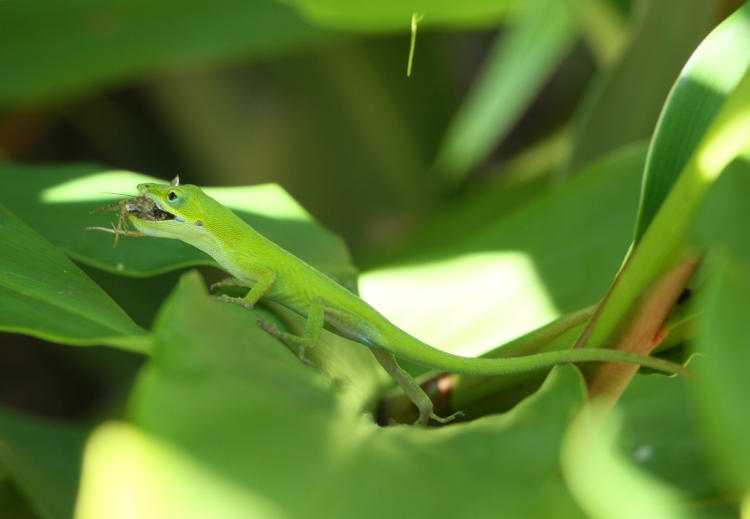
This individual, not even half a meter from where we’d find the vertical one on the leaf, had just captured a small moth and was beating a retreat in the way that they do, which is to move a little, then freeze to allow the camouflage to work its magic. The moth was still kicking, and it might have been the movement from the actual capture that attracted my attention, but it went deeper into shadow before pausing, and my brief opportunity allowed only a couple of frames, none of them critically sharp, – I can’t complain (not true at all, but it means I shouldn’t, anyway.)
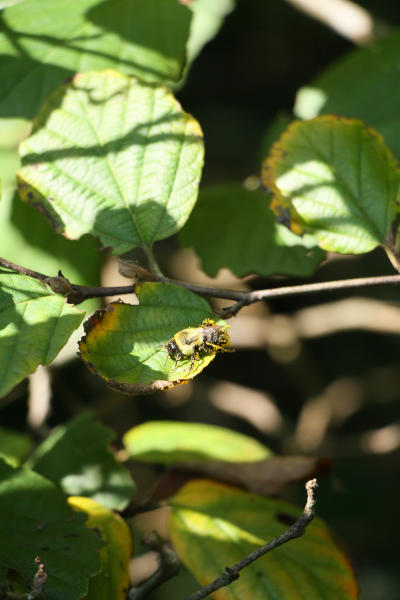 But that provides the segue into the insects.
But that provides the segue into the insects.
Notably, there really wasn’t much activity from the arthropods for this trip, which was curious, especially when a week or so ago I’d spotted several green lynx spiders on the verge of producing egg sacs, and this time, not one, anywhere. Nor any egg sacs. The only thing that comes to mind is the torrential downpour we’d received the previous day, which might have sent them into hiding, but that had been long enough before that I would have thought they’d be out again, since the weather was now clear and pleasant. The green lynx spiders are wonderfully camouflaged, so if some species of bird or whatever came along, I doubt they’d find all of them anyway (or any of them, really.) I looked hard, but without any luck.
Meanwhile, over there to the right is the full frame of a bumblebee or carpenter bee that I was observing, because it landed on a leaf that certainly wasn’t going to present any food opportunities and quickly began trying to divest itself of the pollen load, as if profoundly irritated. Now we can go in for a closer look.

The pollen was quite sizable, potentially from the seashore mallow flowers (Kosteletzkya virginica) that were nearby, but whether it was the pollen itself that was what was irritating the bee, or some kind of parasitic infestation that remained invisible to me, I can’t say – this is almost full resolution, and my examinations turned up nothing but the pollen, which I wouldn’t think was anything that would bother the bee – I have other frames from the same visit that show bumblebees on the flowers, so…
But while we’re on the subject, another frame that I snagged just for giggles.
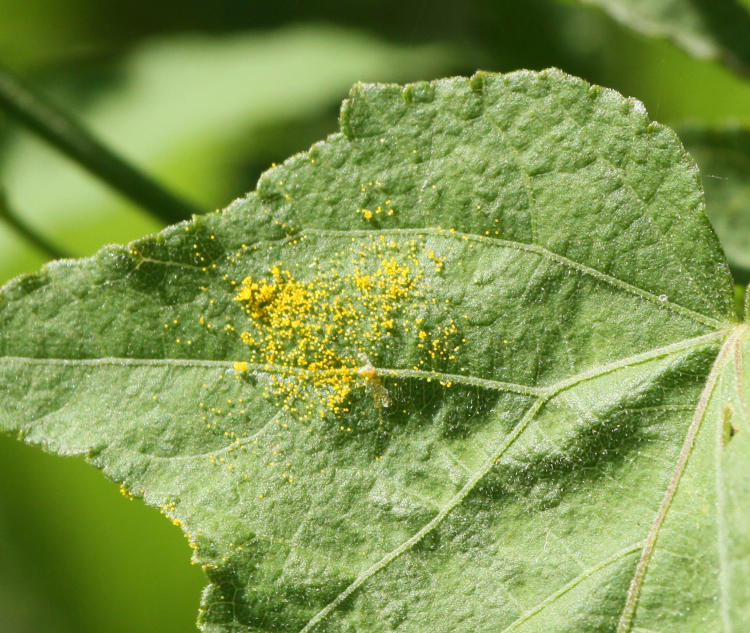
The splash of pollen was so distinct, and so isolated, that I can only assume a similarly-laden bee had blundered rather forcefully into the leaf. They call them bumblebees for a reason, you know.
Elsewhere, a pair of mating wasps landed within camera reach.

These are, I believe, gold-marked thread-waisted wasps (Eremnophila aureonotata) – yes, that’s their whole name. Not all of the gold is their natural coloration – some of it is pollen. I got lucky in that I could manage a portrait view as they flitted in among a dense stand of tall reed-like leaves, some kind of pampas grass I believe. Yes, they’re mating, yes, I’m shameless, and yes, you’ve seen this before, at the same location, which is the only place I’ve ever spotted them. Same pair?
The cardinal flowers (Lobelia cardinalis) were seeing their fair share of visitors.
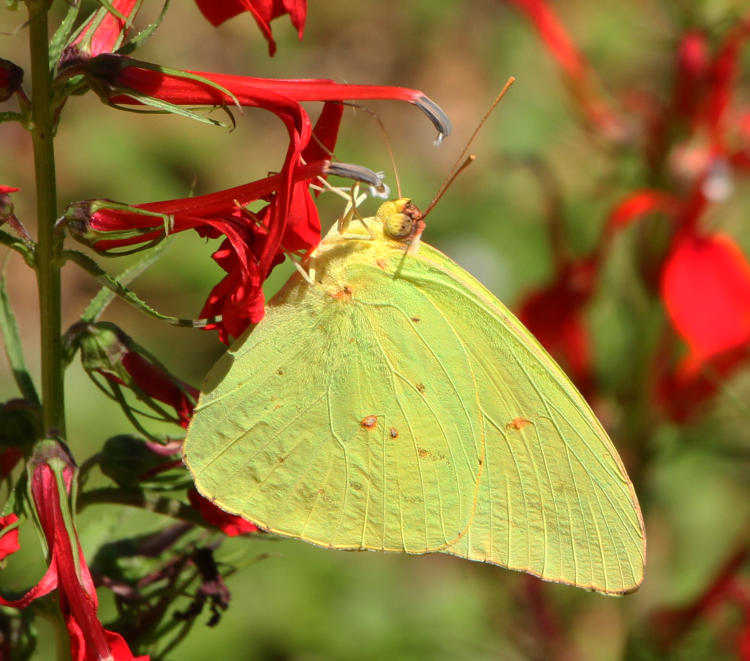
The cloudless sulphur butterflies (Phoebis sennae) really seem to prefer the cardinal flowers, because I’ve gotten numerous photos of them on this species alone. I wasn’t trying terribly hard this time, which was good because they were proving difficult, shy and hyperactive, but I did snag a frame with some nice detail from being flat to the wings, so I’m cool with it.
The next was all skill, or at least, a decent knowledge of spider habits.
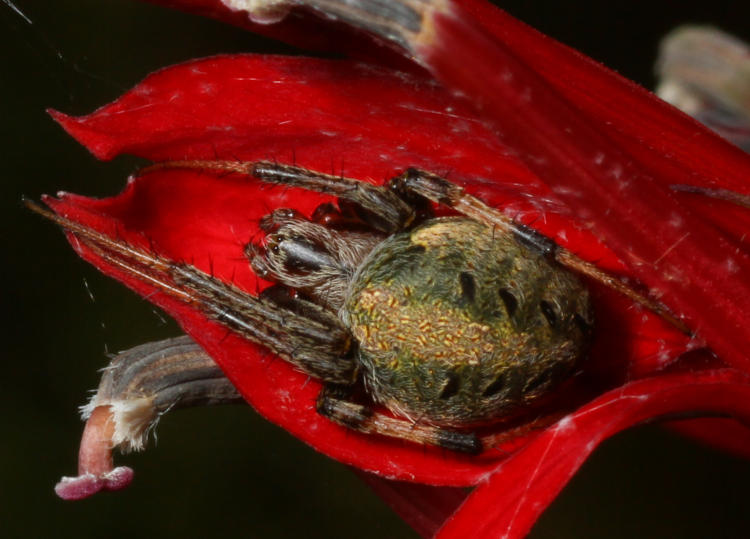
Determining what species this is, however, was another matter. Near as I can tell right now, this is an arabesque orbweaver (Neoscona arabesca,) but I won’t argue with anyone who says otherwise, since the color variations in all of the spotted orbweavers is vast. The web was missing, but the anchor strands were still present, and while typically orbweavers take to the highest anchor point during the day to find shelter, this one was down within easy reach instead of up at the overhanging tree branches that formed the higher anchors. She (it is almost certainly a female) was quite small and deep in shadow, making it hard to determine if it really was a spider until I leaned in quite close, and then the macro flash brought out the real detail.
And finally, a bird, though just a hint of one because they never came too close.

A female ruby-throated hummingbird (Archilochus colubris) had staked out the cardinal flower patch as her own, spending as much time chasing off any interlopers as she did feeding, usually taking to a nearby branch within easy sight to monitor the flowers. Twice, she swooped in to chase off a dastardly trespasser only to find that it was a cicada and not another hummingbird – I can’t blame her, since the appearance and their flying patterns are remarkably similar. The patch was dense, her desire to come close nonexistent, the background complicated, so all I snagged was a couple of half-ass frames, though I may return within a few days and make a concerted attempt. And I’m going to add cardinal flowers to the property next year.
But yeah, still not a bad day, though any day with anoles is a good day. You can quote me on that.




















































